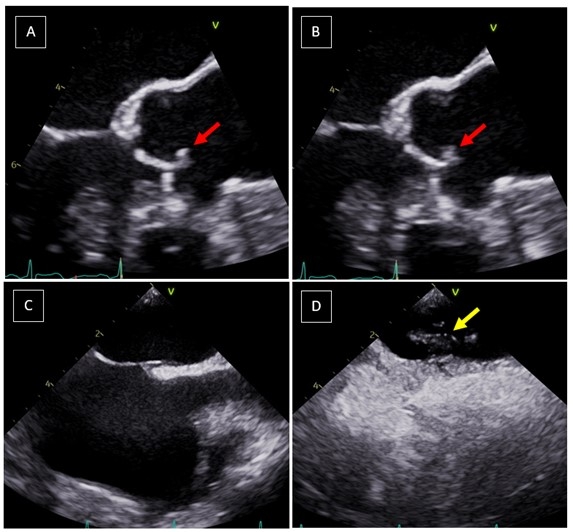Final ID: Su4050
Acute Brain Attack: Peering Through The Esophageal Window In Cryptogenic Ischemic Stroke
Abstract Body (Do not enter title and authors here): The growing adoption of advanced imaging modalities, such as transesophageal echocardiography (TEE), has led to more frequent detection of cardiac structural abnormalities. While intracardiac cardiac tumors and shunts are infrequent and typically asymptomatic, their existence can precipitate severe outcomes, including stroke, myocardial infarction and sudden death.
Case Description: A 69-year-old female presented with left sided facial droop, slurred speech and left arm weakness. A computed tomography angiography revealed focal occlusion of the distal right middle cerebral artery. She was initiated on thrombolytic therapy and experienced resolution of symptoms. Transthoracic echocardiogram revealed right to left shunting consistent with a patent foramen ovale (PFO). Further workup with TEE confirmed the presence of a PFO but also detected a mobile echogenic mass on the aortic valve leaflet, indicative of papillary fibroelastoma (PFE). Cerebral infarction was attributed to an embolic event, with the PFO and PFE being likely culprits.
Discussion: Current guidelines give a conditional recommendation, low certainty of evidence, for PFO closure in adults older than 60 years, although some observational studies have shown some risk reduction in older patients. The key trials showing clinical benefit of PFO closure were in adults younger than the age of 60. For left sided cardiac tumors, such as PFE, guidelines give a 2A recommendation for resection. Addressing the risk for recurrent stroke in this 69-year-old patient was an essential part of stroke care, as such, a multi-disciplinary team of experts including cardiology, neurology, and cardiothoracic surgery was conveyed. The decision was to proceed with surgical intervention in addition to antiplatelet therapy to achieve optimal risk reduction. The patient subsequently underwent successful surgical removal of the PFE with native valve preservation and PFO closure.
Conclusion: Cardiac PFEs and PFOs can be associated with increased stroke risk. Employing appropriate imaging techniques and timely interventions are of utmost importance in stroke management.
Case Description: A 69-year-old female presented with left sided facial droop, slurred speech and left arm weakness. A computed tomography angiography revealed focal occlusion of the distal right middle cerebral artery. She was initiated on thrombolytic therapy and experienced resolution of symptoms. Transthoracic echocardiogram revealed right to left shunting consistent with a patent foramen ovale (PFO). Further workup with TEE confirmed the presence of a PFO but also detected a mobile echogenic mass on the aortic valve leaflet, indicative of papillary fibroelastoma (PFE). Cerebral infarction was attributed to an embolic event, with the PFO and PFE being likely culprits.
Discussion: Current guidelines give a conditional recommendation, low certainty of evidence, for PFO closure in adults older than 60 years, although some observational studies have shown some risk reduction in older patients. The key trials showing clinical benefit of PFO closure were in adults younger than the age of 60. For left sided cardiac tumors, such as PFE, guidelines give a 2A recommendation for resection. Addressing the risk for recurrent stroke in this 69-year-old patient was an essential part of stroke care, as such, a multi-disciplinary team of experts including cardiology, neurology, and cardiothoracic surgery was conveyed. The decision was to proceed with surgical intervention in addition to antiplatelet therapy to achieve optimal risk reduction. The patient subsequently underwent successful surgical removal of the PFE with native valve preservation and PFO closure.
Conclusion: Cardiac PFEs and PFOs can be associated with increased stroke risk. Employing appropriate imaging techniques and timely interventions are of utmost importance in stroke management.
More abstracts on this topic:
Left Ventricular Outflow Tract Gradient and Left Atrial Strain Predict Cardiac Outcomes in Young Hypertrophic Cardiomyopathy Patients
Gearhart Addison, Epstein Sonia, Gauvreau Kimberlee, Mangano Christina, Chen Ming-hui
A Unique STEMI Etiology: Paradoxical Coronary EmbolismDavis Thomas, Saado Jonathan, Kietrsunthorn Patrick, Williams Eric

